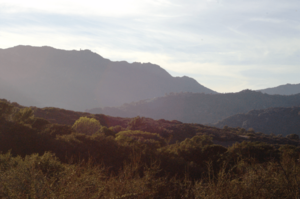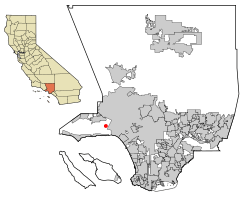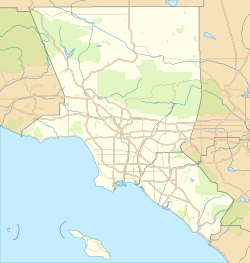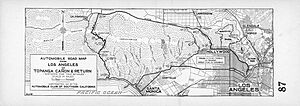Topanga, California facts for kids
Quick facts for kids
Topanga, California
Topaa'nga (Tongva)
|
|
|---|---|

View of Topanga Canyon from one of the hiking trails
|
|

Location of Topanga in California and Los Angeles County
|
|
| Country | |
| State | |
| County | |
| Named for | Topaa'nga, a Tongva word perhaps meaning "where the mountain meets the sea" or "the place above" |
| Area | |
| • Total | 19.137 sq mi (49.563 km2) |
| • Land | 19.129 sq mi (49.543 km2) |
| • Water | 0.008 sq mi (0.020 km2) 0.04% |
| Elevation | 1,084 ft (330 m) |
| Population
(2020)
|
|
| • Total | 8,560 |
| • Density | 447.30/sq mi (172.71/km2) |
| Time zone | UTC-8 (PST) |
| • Summer (DST) | UTC-7 (PDT) |
| ZIP code |
90290
|
| Area code(s) | 310/424, 747/818 |
| GNIS feature ID | 2583164 |
| FIPS code | 06-78960 |
Topanga is a special community located in western Los Angeles County, California, United States. It's nestled in the beautiful Santa Monica Mountains. The name Topanga comes from the Tongva people. It might mean "where the mountain meets the sea" or "the place above."
This area is unique because it's mostly undeveloped. It's the largest unincorporated area in Los Angeles County. This means it's not officially a city, but a community managed by the county. As of 2020, about 8,560 people live here. Topanga is known for its natural beauty and a relaxed, artistic vibe.
Contents
A Look Back in Time
Who Lived Here First?
The name Topanga was given by the Tongva tribe. They were the Native American people who lived here first. This area was the western edge of their land. The Chumash tribe lived just to the north, along the coast. You can still find ancient mortars carved into rocks. These were used by the tribes to grind food.
How Did Topanga Grow?
Europeans first settled in Topanga in 1839. In the 1920s, Topanga Canyon became a popular spot. Hollywood stars built cottages here for weekend getaways. The hills and plants offered privacy and beautiful views for the rich and famous.
A Hub for Artists
During the 1960s, Topanga Canyon became a magnet for artists. Many creative people moved here. For example, musician Neil Young lived in Topanga. He even recorded parts of his album After the Gold Rush in his basement studio in 1970.
The Topanga Corral was a famous nightclub. It hosted many different musicians. Some of them were local Topanga artists. Bands like Canned Heat and Little Feat played there. Famous singers like Taj Mahal and Emmylou Harris also performed.
Exploring Topanga's Nature
Topanga Canyon's Geography
Topanga Creek flows through Topanga Canyon. It's one of the biggest watersheds that flows into Santa Monica Bay. This creek is special because it's one of the few local waterways that isn't dammed. It's a place where steelhead trout come to lay their eggs. The area usually gets about 22 inches (56 cm) of rain each year.
Topanga Beach is right where Topanga Creek meets the ocean. State Route 27, also known as Topanga Canyon Boulevard, is the main road. It connects the Ventura Freeway (US 101) in the north to Pacific Coast Highway (SR 1) in the south.
Parks and Wildlife
Topanga Canyon is home to Topanga State Park. This is the largest park in the Santa Monica Mountains. It's one of the biggest open space preserves in the world that's surrounded by a city. It's part of the Santa Monica Mountains National Recreation Area. The park has many different native plants. You can find areas with California coastal sage and chaparral ecoregion and California oak woodland.
Topanga's Weather
Topanga has a warm-summer Mediterranean climate. This means it has warm, dry summers. The average monthly temperatures don't get too hot, staying below 71.6°F (22°C).
Who Lives in Topanga?
In 2010, Topanga had a population of 8,289 people. Most residents were White. About 6.4% of the population was Hispanic or Latino. The average household income was about $120,711. This shows that Topanga is a fairly wealthy community.
Most people in Topanga live in homes they own. About 75.2% of homes are owner-occupied. The community has a mix of families with children and older adults. The median age in Topanga was 46.1 years.
Lower Topanga Canyon's Story
The part of Topanga Canyon closest to the ocean, called Lower Topanga, has an interesting history. For many years, a private club from Los Angeles owned this land. They rented out plots at very low prices. This made Lower Topanga a unique place. It became one of the last spots where the relaxed, artistic hippie lifestyle of Topanga Canyon continued.
A Special Place for Native Americans
The Chumash people believed Lower Topanga was a sacred place. It was important for meetings and trade among different tribes. One area, called the "Rodeo Grounds," got its name from a real rodeo arena that was there in the 1800s.
From Fishing Village to Artists' Haven
In the early 1900s, Lower Topanga was a Japanese fishing village. Later, William Randolph Hearst, a famous newspaper publisher, owned the land. He turned it into a weekend escape with beach shacks for his guests.
In the 1960s, a lively community of artists and surfers moved in. They took care of their homes themselves. They even helped protect their neighborhood from floods and wildfires. The roads in Lower Topanga remained unpaved, adding to its rustic charm.
Changes in Lower Topanga
In 2001, the land in Lower Topanga was sold to California State Parks. Even though the community was small, State Parks decided to move everyone out. They wanted to return the area to its natural state. The last residents were asked to leave in 2006. Now, groups like TreePeople are working to restore the area. They want it to look as it did before any buildings were there.
Topanga's Culture and Community
Topanga is known as a bohemian place. This means it attracts artists, musicians, and filmmakers. Many music festivals happen here, like the Topanga Days Festival and Topanga Earth Day. The Topanga Film Institute also hosts an annual film festival.
The Theatricum Botanicum
In the 1950s, actor Will Geer moved his family to Topanga. He was on a blacklist at the time, meaning he couldn't work in Hollywood. His friend, musician Woody Guthrie, also had a small shack on the property. They accidentally started what became an artists' colony.
Today, the Geer family still runs the Will Geer Theatricum Botanicum. It's an outdoor theater that opened in 1973. It's a professional theater that puts on plays by Shakespeare and other classic and new works. They also have music concerts. Famous performers like Pete Seeger and Arlo Guthrie have played there.
Fun Events in Topanga
Every Memorial Day weekend, Topanga hosts an annual fair and parade called Topanga Days. It's held at the Topanga Community House. The fair has music, dancing, craft vendors, and lots of food. A parade also takes place on Memorial Day.
Topanga Canyon also has an annual reggae festival called Reggae on the Mountain. It's one of the biggest events in the area. This event helps raise money for the Topanga Community Club.
The Topanga Film Institute puts on the annual Topanga Film Festival every July. This festival aims to connect different cultures and build community.
Local Life
Topanga has two outdoor shopping centers with local businesses. You won't find any big chain stores, hotels, motels, or gas stations here. This helps keep Topanga's unique local feel.
The natural beauty of the Santa Monica Mountains is a big part of Topanga's culture. There are streams, waterfalls, and amazing rock formations. You can find viewpoints with wide views of the mountains, the Pacific Ocean, and Los Angeles. Many trails are available for hiking, mountain biking, horseback riding, birdwatching, and rock climbing. These activities are very important to the people who live here.
Learning in Topanga
Public Schools
Most students in Topanga go to schools in the Los Angeles Unified School District. Here are some of the schools:
- Topanga Elementary School: Parents often help with music and art lessons here. This helps the school have high test scores.
- For middle school, students can choose between Revere Charter Middle School or Woodland Hills Academy.
- For high school, students can choose between Palisades Charter High School and Taft High School.
Some parts of Topanga are in other school districts. These include the Santa Monica-Malibu Unified School District and the Las Virgenes Unified School District.
Private Schools
There are also private schools near Topanga:
- Manzanita School at Big Rock Ranch
- Viewpoint School in Calabasas
The County of Los Angeles Public Library also has a library branch in Topanga.
Famous People from Topanga
Many well-known people have lived in Topanga. You can find a full list in the article: List of people from Topanga, California.
Images for kids
See also
 In Spanish: Topanga (California) para niños
In Spanish: Topanga (California) para niños







